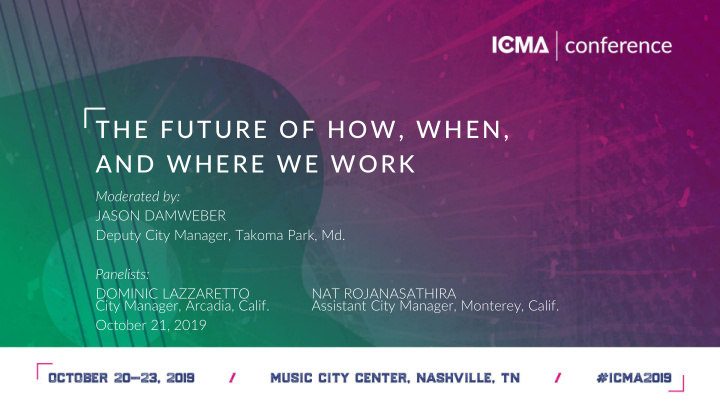



THE FUTURE OF HOW, WHEN, AND WHERE WE WORK Moderated by: JASON DAMWEBER Deputy City Manager, Takoma Park, Md. Panelists: DOMINIC LAZZARETTO NAT ROJANASATHIRA City Manager, Arcadia, Calif. Assistant City Manager, Monterey, Calif. October 21, 2019
Be different, Innovation happens within city hall. Stand out, and work your Local governments innovate when we stop telling ourselves “ that ’ s the way it ’ s always been done ” and start seeking better butt off. ways to deliver public services. Reba McEntire A culture of innovation starts with attracting and retaining the right people, and nurturing an environment of collaborative thinking and new ideas. This is the future of how, when, and where our local governments will serve communities.
MEET THE PANEL Jason Damweber Dominic Lazzaretto Nat Rojanasathira Deputy City Manager City Manager Assistant City Manager Takoma Park, Maryland Arcadia, Calif. Monterey, Calif.
CAL-ICMA ’ S TALENT 2.0 REPORT A comprehensive analysis of challenges and best practices on recruiting, retaining, and developing local government employees.
Talent 2.0 Report: Modern Approach to Attracting & Retaining Top Talent in Local Gov. • Survey of 372 senior managers throughout California • Interviews with private and nonprofit thought leaders • 11 statewide focus groups with 272 local government managers • Unveiled Talent 2.0 Report in Spring 2018
Recruitment Retention Challenges Challenges • Fewer department • Training & Development not heads/division managers to enough of a priority “ steal ” from other agencies • Long commutes, high cost of • Internal candidates often lack housing and child care experience and “ soft skills. ” • Traditional and “ stodgy ” • Hiring process can be lengthy cultures can be uninspiring for early professionals • Job specs (duties, work schedules) can be inflexible • Political infighting/discourse • We don ’ t effectively brand or • Mid-career professionals promote our agencies
“ Take time to deliberate; but when the time for action arrives, stop thinking and go in. ” - Andrew Jackson 7th President of the United States U.S. Senator from Tennessee
THE FUTURE OF HOW WE WORK Our investments and mindset today will affect the future of how we work tomorrow.
How we worked... In the 1950s and 1960s: • Manual input • Stenographers and Typists • Secretaries, limited technology • Wore suits, ties, and dresses • “ Suited up bureaucrat. ” Seattle Municipal Archives, 1945
How we work... Today: • More flexible attire policy, but still not relaxed • Still have siloed workplaces • Union regulations create barriers to innovation
How will we work... Tomorrow: • Broader, more multidisciplinary job descriptions • Utilizing adaptive technology • Ongoing feedback from anywhere, any supervisor • Cross-departmental teams and collaboration are the norm • Still need time face-to-face
THE FUTURE OF WHEN WE WORK It ’ s more than smartphones.
When we worked... In the 1950s and 1960s: • 8 to 5 • Monday through Friday • Compulsory retirement at 62, 65
When we work... Today: • Flexible when family calls • Most non-hourly employees are available nights and weekends on their phones • Some workplace flexibility: ➤ Flextime ➤ Telecommuting (sometimes) ➤ Compressed schedules: 9/80 or 4/10
When will we work... Tomorrow: • Anytime • Not necessarily during traditional “ office hours ” • But still together, most of the time • Customizable to different employees, different needs
THE FUTURE OF WHERE WE WORK Will it just be anywhere?
Where we worked... In the 1950s and 1960s: • Government office buildings, often uninspiring • Individual, task-driven environment
Where we work... Today: • More dynamic environments • Still very “ siloed ” • Some modern workspaces with ‘ hoteling, ’ group meeting space, undedicated work stations
Where we will work... Tomorrow: • More dynamic workspaces: • Individual & Hoteling • Small Teams • Large Groups • Remote, some but not all of the time
I ’ ve been Working Remotely workin ’ all week and I ’ m • 43% of employees work remotely all or some of the tired … I wanna time (Gallup, 2017) have fun, it ’ s • Chinese call-center employees working from home time for a good increased productivity by 13% (Stanford) time. ” • Remote workers log longer hours than office-bound counterparts -Alan Jackson “ Good Time ”
Personal Collaborative Productivity Efficiency • Let people work when or • The speed at which a group where they want solves a problem • The office can be distracting • Can be more productive in groupwork / close quarters • Jobs: • “ Chance encounters and • Finance (Accountants, Auditors) interactions between • HR knowledge workers improve performance “ (MIT) • Engineers • Planners, Analysts • Maintenance Staff!
How do co-pilots collaborate?
HOW DO WE GET THERE? Local governments must adapt today to support tomorrow ’ s workforce.
ADAPT 1 2 3 CUSTOMIZE ORGANIZATIONAL CREATE “ PERSONAL UPGRADE YOUR TECH PRODUCTIVITY ” TIME & INDIVIDUAL NEEDS Modernize tools for employees to do work Identify shared blocks of Not all positions, anywhere and anytime time when we avoid employees, and meetings. expectations are created equal.
Q&A www.cal-icma.org/talentinitiative Thank you
Recommend
More recommend